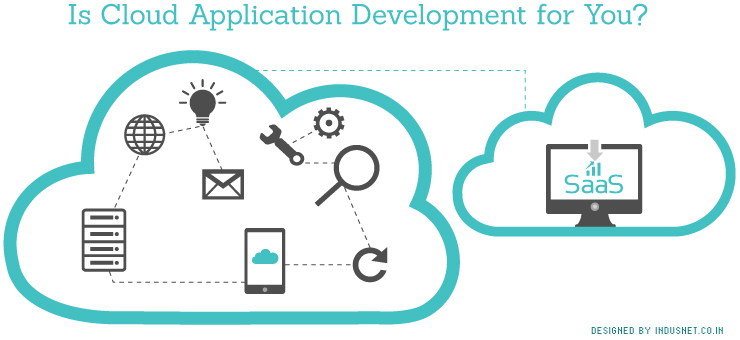
Is Cloud Application Development for You?
Developing applications on a cloud-based platform entails your development team acquiring suitable skill sets. Despite its challenges, it distinctly leverages the capability of your organization. Cloud application development can be done in SaaS (Software as a Service), IaaS (Infrastructure as a Service) and PaaS (Platform as a Service). According to a recent Gartner report, “Enterprise IT spending on public cloud computing, within addressable market segments, will overtake spending on traditional IT in 2025. In 2022, more than $1.3 trillion in enterprise IT spending is at stake from the shift to cloud, growing to almost $1.8 trillion in 2025.” The statistics clearly indicate that cloud application development is becoming crucial for organizations’ IT mix. Developing applications in the cloud comes with ample benefits like: Enabling developers to take virtual snapshots of troubling applications Leveraging economies of scale Improving productivity Cost efficiency and lifecycle management Challenges faced by developers Due to its ability to run the same program on many different systems, Java is one of the top cloud programming languages. Here we have listed some of the unique challenges faced by Java developers during development: 1. Fragmented data As the business grows, the number of cloud applications deployed increases. Every application solves a different business problem. But this has resulted in fragmentation of business data across various disconnected applications. Developers are increasingly using low-code platforms to build applications. Though data can be easily tracked and may look to be at the same place, it is actually fragmented. Writing custom point-to-point integration in APIs or by adopting a standalone cloud integration platform like Zapier, Dell Boomi or Informatica, can solve this problem. Nonetheless, this task does require a specialized skill set in the development team. 2. Understanding application resource dependencies A cloud application often runs in a distributed environment with at least two servers deployed for the operation. The primary focus for a developer is to understand application service dependencies. Application service dependencies include databases, message servers etc. In a cloud environment, several services interact amongst each other and developers can’t be sure what IP address the application uses. On the contrary, in a traditional application development environment, identification of resources is easy and a developer knows what service is being used by the application on deployment. Hence, the developer needs to understand service usability and be able to locate resources. Quite often, developers use a discovery pattern to find the services. In a Java application environment, the developer gets JNDI (Java Naming and Directory Interface) that helps in locating the services required. Resource mapping during deployment helps developers to avoid hard coding by following a logical sequence. 3. Addressing horizontal scalability In cloud computing, horizontal scalability is the ability of the application to connect with multiple hardware or software such as servers when required. The connection enables the whole system to function as a single logical unit. Cloud applications, owing to their parental nature, are horizontally scalable. But unfortunately, not all applications are horizontally scalable. This issue can be resolved by writing applications in a manner that renders them potentially scalable. 4. Precautionary measures Localizing data storage can be fatal to your cloud infrastructure. The essence of cloud computing is to have distributed data management to dodge server failures. Furthermore, developers must rely on location patterns to abstract physical IPs rather than using physical IP or disk-based locators to find out resources for using in the application. 5. Testing application in the cloud Developers often face the challenge of testing the application in a cloud environment. The transition process of application from the local environment to the cloud environment for testing is not free from glitches. Only a smooth transition will ensure product development cycle. So, the use of appropriate testing tools is important for a smooth transition. 6. Inability to differentiate The majority of the organizations are relying on the same technology and same cloud-based platforms. So, it has become difficult for them to offer unique features to their clients. This undermines their ability to gain a competitive edge over others. No doubt, the development of cloud applications is cheaper and more efficient. But developers need to devise new capabilities, new strategies and follow an innovation-driven approach to entice their clients. Advantages of application development in the cloud The leading cloud-based development platforms in PaaS and IaaS include Google App Engine, Amazon Web Services, Microsoft Azure and Salesforce.com. Metrics review has already proven that cloud application development offers a lot of benefits like: 1. Save application development and deployment time The application development time in the cloud is significantly lowered owing to the cloud platform’s ability to streamline the development process. The platform is further capable of quickly getting development assets online. Traditionally, the development of custom applications used to take months as developing a complete application required additional components. However, with cloud computing services, developers can quickly avail all the required software and tools in the cloud working their way out more efficiently. Furthermore, cloud applications can be deployed quickly by getting into production mode thus enabling less time to market. 2. Cost-effective development environment By delivering applications through the SaaS model, organizations can save a lot of costs. Both financial and infrastructural worries have been side-lined by incorporating cloud computing services for application development. The capital investment required to set up a complex environment for building, testing and deploying custom applications was unfeasible for many small-scale organizations. The subscription models in cloud computing offer the clients the flexibility to spend as per their demand and avoid tying up additional hardware/ software costs. 3. Simple and efficient Developers can easily access applications through a web browser. Even the most complex enterprise-level applications are developed without actually getting into technical complications. 4. Optimum utilization of resources The IT resources are efficiently utilized while application development in the cloud. Moreover, applications utilizing virtualized IT services are technically more efficient and